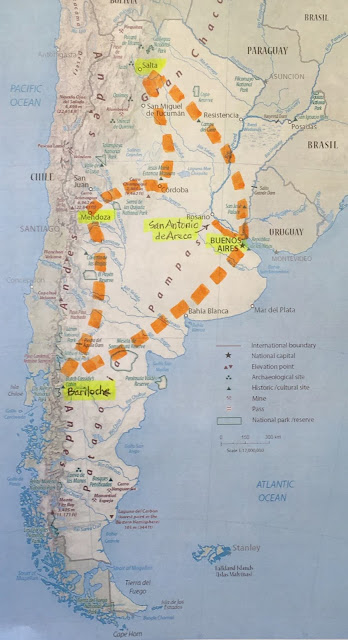Any adventure shared with a sibling is to be celebrated—especially if you’re both in your mid- to late seventies. My recent 18-day jaunt around Argentina with my brother, Dan, was not just an empowering, bonding experience for us, but a delicious introduction to the many colors and flavors of this incredibly diverse and breathtakingly beautiful country.
Starting in Buenos Aires, we spent three days each in five distinct corners
of the country, traveling mostly by air to maximize our time at every destination. I will do my best to transport you to one of them briefly in each post in this series. They will include the areas in and around Buenos Aires, San Antonio de Areco, Salta, Mendoza and Bariloche / San Martin de los Andes.
But first, a few impressions of Argentina as a whole. (Now I realize how presumptuous it is to characterize a country by one’s experiences in just one part of it or with just that narrow cross-section of people one encounters in most tourist-oriented places. However, since Dan and I covered such a range of locales and generally managed to avoid outrageously touristy attractions, I guess I’ll take a stab at it.)
ARGENTINA – DIVERSITY WITH SHADES OF EUROPE
Argentina is the eighth largest country in the world by area, spanning over twenty degrees of latitude. In terms of terrain, climate and residents’ ancestry, it is one of the most diverse. A nearly 5,000-kilometer-long seacoast; a spine of snow-capped mountains; the vast Pampas plains; glacier-fed rivers and lakes; lush forests, parched desert…it has it all. And, of course, all these varying environments have shaped and colored their inhabitants and the cultural influences they’ve brought with them from Europe and beyond.
Argentinians struck us as generally healthy, happy and very proud of their country. Everywhere we went, they were kind, helpful and patient with our many questions and efforts to fit in.
This appears to be a prosperous, cosmopolitan country, its infrastructure and natural assets well tended, and its people educated, aware and culturally sophisticated—and, should I mention, quite beautiful. From design, to music, to food, to language, the European influences—Spanish, German and Italian—are unmistakable.
 |
| PHOTO: Raul Urzua via Wikipedia |
As I’d expected, most folks managed to understand my Mexican-accent Spanish quite well, while I had some trouble picking up the different pronunciations and vocabulary of Argentinians, especially the swishy Castellano del Rio de Plata spoken by many in Buenos Aires. Nonetheless, in the time it took for a cab ride across town I was usually getting the hang of it with the driver. Much-needed practice for my listening skills!
 Also quite evident in the capitol city is the Italian influence on the language. I overheard many conversations pulsating with the kind of “pogo-stick” accent pattern one associates with Italians—you know, with their animated hand gestures and all.
Also quite evident in the capitol city is the Italian influence on the language. I overheard many conversations pulsating with the kind of “pogo-stick” accent pattern one associates with Italians—you know, with their animated hand gestures and all.Our purchasing power got us most things for one-quarter to one-third of what they’d cost in the United States.
MONEY: SPOILED…AND SOAKED
We’d been forewarned that it might be difficult obtaining pesos in the country. First off, the slumping exchange rate with the U.S. dollar—now about 60 to one and growing—has made dollars quite desirable for their relative stability.
We expected many businesses to prefer dollars over pesos, though we encountered only one (a fishing guide we hired late in the trip) who required payment in dollars. Generally, we felt our purchasing power got us most things for one-quarter to one-third of what they’d cost in the U.S.
Banks, as usual, manage to carve out their pound of flesh—or should I say about three pounds: no matter where we were, withdrawing the maximum amount of cash allowed in a single ATM transaction—about $60 usd—incurred a fee of $10.
LOMO LOWDOWN
It’s true what they say: Argentina is big on beef…and wine. Everywhere we went, about half of the menu items were beef; the other half, everything else. It was quite a dilemma for this wannabe do-gooder looking to cut back on beef for its unsustainable environmental impact.
(Once lauded for its free-range, grass-fed production model, the Argentine beef industry has largely turned to industrial-scale feedlots and can no longer claim an environmental “pass.”)
 Okay, I did order beef…a few times. Enough to learn the difference between the cut they call chorizo—kind of like our sirloin, about half fat and gristle—and bife de lomo which, as essentially a filet mignon, is thick, lean, even-textured and tender enough to cut with your fork, though certainly not as flavorful as some other, better-marbled cuts.
Okay, I did order beef…a few times. Enough to learn the difference between the cut they call chorizo—kind of like our sirloin, about half fat and gristle—and bife de lomo which, as essentially a filet mignon, is thick, lean, even-textured and tender enough to cut with your fork, though certainly not as flavorful as some other, better-marbled cuts.As for the wine, again, it dominates the scene—and the shelves in any store. If there’s a national grape variety, it would be malbec. Though I’m by no means a wine aficionado, I tasted enough malbecs, some of them quite respectable, to conclude that I actually prefer a good cab. (I’ll touch on this a bit more in my later post on our experience in the wine country around Mendoza.)
(Stay tuned right here for my next post: GOOD AIRS — A Too-brief Introduction to Buenos Aires.)








No comments:
Post a Comment